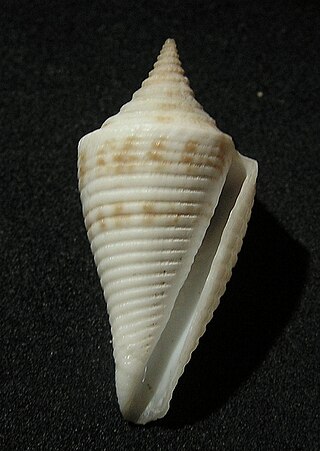| Conoidea | |
|---|---|
 | |
| A live Californiconus californicus , in situ , anterior end on the right | |
| Scientific classification | |
| Domain: | Eukaryota |
| Kingdom: | Animalia |
| Phylum: | Mollusca |
| Class: | Gastropoda |
| Subclass: | Caenogastropoda |
| Order: | Neogastropoda |
| Superfamily: | Conoidea Fleming, 1822 [1] |
| Families | |
See text | |
Conoidea is a superfamily of predatory sea snails, marine gastropod mollusks within the suborder Hypsogastropoda. This superfamily is a very large group of marine mollusks, estimated at 340 recent valid genera and subgenera, and considered by one authority to contain 4,000 named living species. [2]
Contents
This superfamily includes the turrids, the terebras (also known as auger snails or auger shells) and the cones or cone snails. [2] The phylogenetic relationships within this superfamily are poorly established. Several families (especially the Turridae), subfamilies and genera are thought to be polyphyletic. [2]
In contrast to Puillandre's estimate, Bandyopadhyay et al. (2008) [3] estimated that the superfamily Conoidea contains about 10,000 species. Tucker (2004) even speaks of 11,350 species in the group of taxa commonly referred to as turrids. [4] 3000 recent taxa are potentially valid species. Little more than half of the known taxa are fossil species. Many species are little known and need more investigation to find their exact systematic place. [4]
Most species in this superfamily are small to medium, with shell lengths between 3 mm and 50 mm. They occur in diverse marine habitats from tropical waters to the poles, in shallow or deep waters, and on hard to soft substrates.
The superfamily is known for its toxoglossan radula, which is used to inject powerful neurotoxins into its prey. This makes these species powerful carnivorous predators on annelid, other mollusc and even fish.
Within the superfamily there are four somewhat different varieties of radula. [5] The radula types [6] are as follows:
- Type 1 Drilliidae type: five teeth in each row with comb-like lateral teeth and flat-pointed marginal teeth
- Type 2 Turridae s.l. type: two or three teeth in a row with the marginal teeth being of the duplex or wishbone form
- Type 3 Pseudomelatomidae type: two or three teeth in a row with curved and solid marginal teeth
- Type 4 hypodermic type: two hollow, enrolled, marginal teeth in each row with an absent or reduced radular membrane
In 2009, a proposed new classification of this superfamily was published by John K. Tucker and Manuel J. Tenorio. In 2011, a new classification of this superfamily was published by Bouchet et al. Both classifications were based upon cladistical analyses and included modern taxonomic molecular phylogeny studies.
















